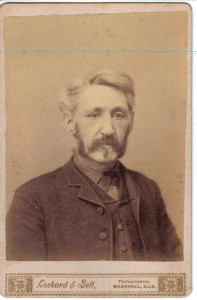The cabinet card was a style of photograph which was widely used for photographic portraiture in the late 1800s. It consisted of a thin photograph mounted on cardstock. A traditional cabinet card consists of a 4″ X 5 1/2″ photo mounted on 4 1/4″ x 6 1/2″ card stock. The imprint of the photographer typically appeared in the extra 1/2″ to 1″ of space at the bottom of the card.
 The cabinet card first appeared in 1863 in London and soon began to displace the smaller carte-de-visite which was introduced in the 1850s. Unlike the carte-de-visite which was often mounted in an album and not really suited for open display, the larger cabinet cards were ideal for displaying in parlors, on table tops and in cabinets.
The cabinet card first appeared in 1863 in London and soon began to displace the smaller carte-de-visite which was introduced in the 1850s. Unlike the carte-de-visite which was often mounted in an album and not really suited for open display, the larger cabinet cards were ideal for displaying in parlors, on table tops and in cabinets.
For nearly three decades after the 1860s, the commercial portraiture industry was dominated by the carte de visite and cabinet card formats. In the 1890s the number and variety of card photograph styles expanded, partially in response to declining sales. Manufactures of standardized card stock and print materials hoped to stimulate sales and retain public interest in card photographs.
As technology improved and photography became more common, the cabinet card continued to lose its place. People wanted photographs that they could enlarge and frame, or smaller unmounted snapshots they could collect in scrapbooks and albums. With the introduction of the affordable Kodak Box Brownie camera in 1900, people increasingly began taking their own photographs. Thus, the popularity of the cabinet card declined rapidly after 1900. Although cabinet cards continued to have a presence in the early 1900s, by the 1920s they were no longer produced at all.
Dating the cabinet cards. See…